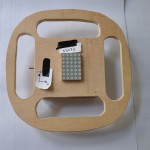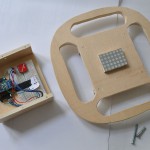Arduino Prototype: The “plate” Gaming Device
For two or three years I wanted to work seriously with Arduino. During this time I have done the same basic LED exercises again and again. Just for keeping alive my basic knowledge. Finally and luckily, I had to visit the Advanced Microcontroller lecture by Laurent Mignonneau. Laurent is the definition of a Geek himself. Not much talking, just doing, and a fucking huge amount of knowledge in electronics and programming. The assignment for his lecture was to create SOMETHING with a low resolution screen. Really advanced examples of a low resolution screen are the androp project (Making of | strobo animation) or Laurent's solar display (concept).
However, one day in May I woke up and had this game device idea, which looks like a plate or a steering wheel. After some consideration the idea felt good. The very simple form allows me to integrate a low resoultion screen very easily. Furthermore the usage range of this kind of device would be broad. I was very happy. For the size of the device I got inspiration of a real plate. It has the perfect size for not entering the private area of other players, but still feel connected to them. The metaphor came to me when I observed the interaction between a waiter and his guests in a restaurant. When the waiter hands the plate to one guest, there exist for a short time a connection between them. The connection is mediated and supported by the plate. The physical distance provided by the plate is small enough for feeling welcome, but also big enough for respecting the private zone. For this reason the form of the device is not only usable for a remote control, it is even usable for a multiplayer gaming device. In this context I got a childhood memory... uh yeah... fighting all the time with my sister for the power of the TV remote control. That memory brought me to a new version of the game "tug of war". The plate has four handholds. For each player one. In the middle of the device the screen is placed. The screen shows two lines, like a cross. The aim of the game is to pull the device hard enough, that one line (the opposite line of the player) comes closer. If the line jumps out of the screen the player has won. An arrow shows it. Afterwards the game starts again. I uploaded a short video for getting an idea and see the device in action.
The technical implementation of my device is very simple, I have to admit... The wood and some other fixing stuff I found in the trash of the university and the Linzer DIY stores. I had almost the feeling of Gambiologia 😉 However, I cut the wood our university wood workshop. Further parts were:
- Board: Arduino Nano (ATmega168)
- Display: Kingbright LED DotMatrix TC20-11YWA
- Interaction: Triple Axis Accelerometer Breakout - ADXL335
- some cables and resistors
During development I ran into some pitfalls. My soldering skills are not very great and for this reason at least four or five times a cable lost the connection... In the end I stabilized the cable connection with hot glue (look at the pictures). That worked very well and I had no such problems anymore. Laurent gave me the advice to avoid cables everywhere I can. The possibility that the cable lost the connection is very high. Using plugs and connectors are good alternatives... So for the next projects I try my best to consider it. Second pitfall was related to programming. I got a Arduino Nano Board from Laurent. I tried to replace the Nano board with my Uno board. But unfortunatley the provided Arduino Code for the LED Dot Matrix messed up. In the end the Arduino Code for Nano board was not compatible with my new Arduino Uno board. I don't know the exact reason. May one of my readers have an idea?! I would appreciate it. 🙂 Next issue, not a very big one, was dealing with the accelerometer data. Every motion caused a motion in the opposite direction. You can see the values at my Excel File. I implemented a simple time checking code for the sensor. It works good for the first tests, but maybe one of you can recommend me a good library or code snippet for dealing with accelerometer values...?! The source code of this project is available as usual on my Google SVN. I am pretty happy with the result of my first Arduino project. Even the feedback I got from the other students were great. So I would like to continue the development. For a much better wood cut I hope I can use the laser cutter at the AEC or the Fab lab in Berlin. The device should get some extensions, like pressure sensors on each handhold. Adding four InraRed LEDs on the back of the device. The IR LEDs are interesting for some (3D) tracking projects a la Johnny Chung Lee. I hope I can implement all these ideas... Happy coding and soldering!







